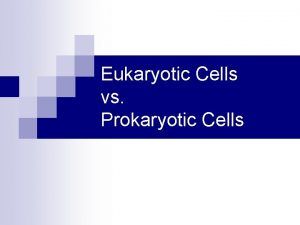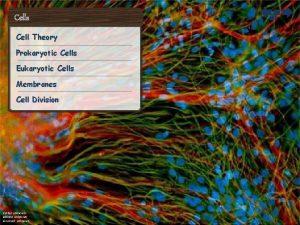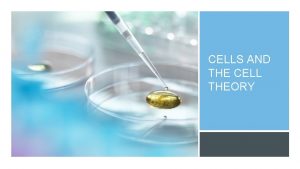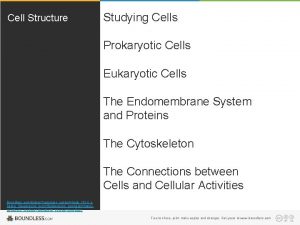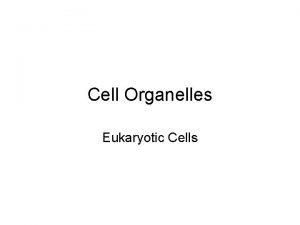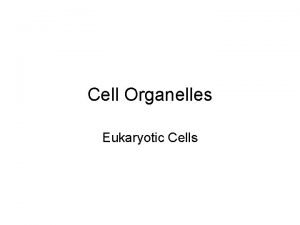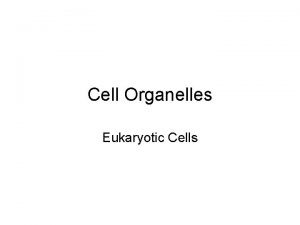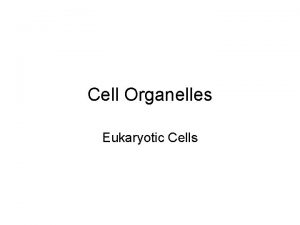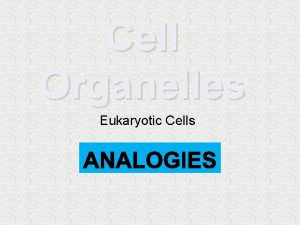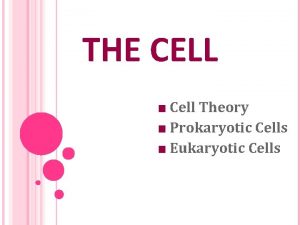UNIT 2 CELLS Explain the role of cell


















- Slides: 18

UNIT 2: CELLS Explain the role of cell organelles for both prokaryotes and eukaryotes cells, including cell membrane, in maintaining homeostasis and cell reproduction.

Cell Membrane Structure �- Structure: Consists of a phospholipid bilayer ( 2 layers – bi = 2) �Fluid Mosaic Model-various parts that make up the membrane are fluid or freely moving 1. Hydrophilic heads-made of phosphate, like water 2. Hydrophobic tails-made of lipid(fat), hate water 3. Protein Channels-helps large molecules in and out 4. Protein Gates-used in active transport

Cell Membrane � Cell Membrane a. k. a. plasma membrane �- Separates the inside of a cell from its environment. �SEMIPERMEABLE or selectively permeableallows some things to get in, while other things stay out.

Cell Membrane Function �- Function: Controls what enters and leaves the cell in order to maintain homeostasis (internal balance a cells must maintain even if the external environment changes – This is needed for survival)

Cell Membrane Transport �The cell membrane helps the cell maintain homeostasis through cell transport- how substances get into and out of cells �There are 2 types of Cell Transport: A. Active Transport-requires energy B. Passive Transport-does NOT require energy

Cellular Transport A. Passive Transport – energy IS NOT required to move molecules across the cell membrane. Molecules move from an area of HIGH concentration to an area of LOW concentration WITH the concentration gradient. **THINK HIGH TO LOW, GO WITH THE FLOW!!

Passive Transport 1) Diffusion – SMALL molecules, like oxygen, can pass right through the cell membrane by slipping between the phospholipids Initial Conditions Low High Diffusion High Low Dynamic Equilibrium

Chapter 7 Cellular Structure and Function 7. 4 Cellular Transport § Diffusion is controlled by § Temperature § Pressure § Concentration Dynamic Equilibrium § When diffusion of material into the cell equals diffusion of material out of the cell

Passive Transport 2) Facilitated Diffusion – LARGE molecules, like sugar, must pass through the protein channels in the bilayer

Passive Transport 3) Osmosis § Diffusion of water across a selectively permeable membrane Three Types of Solutions A. Isotonic B. Hypotonic C. Hypertonic

Chapter 7 Cellular Structure and Function 7. 4 Cellular Transport A. Isotonic Solution § Water and dissolved substances diffuse into and out of the cell at the same rate. Plant Cell Blood Cell 11, 397 x

Chapter 7 Cellular Structure and Function 7. 4 Cellular Transport B. Hypotonic Solution § Solute concentration is higher inside the cell. § Water diffuses into the cell. § BLOWS UP the cell. Plant Cell Blood Cell 13, 000 x

Chapter 7 Cellular Structure and Function 7. 4 Cellular Transport C. Hypertonic Solution § Solute concentration is higher outside the cell. § Water diffuses out of the cell. § SHRINKS the cell. Plant Cell Blood Cell 13, 000 x

Solutions


Active Transport 2) Active Transport – energy IS required to move molecules across the cell membrane. Molecules move from an area of LOW concentration to and area of HIGH concentration AGAINST the concentration gradient.

Types of Active Transport � 1) Protein Pumps – Molecules are “pumped” through the cell membrane through protein gates � 2) Endocytosis – mass is surrounded by a cell and is taken into the cell � 3) Exocytosis – mass is removed from the cytoplasm and is “expelled” out of the cell into its environment �https: //www. youtube. com/watch? v=mv 6 Ehv 06 m. XY �https: //www. youtube. com/watch? v=pv. Oz 4 V 699 gk

Cellular Transport
 Onodi cells
Onodi cells Papillary duct of bellini
Papillary duct of bellini Parafollicular cells vs follicular cells
Parafollicular cells vs follicular cells Somatic vs gamete
Somatic vs gamete Why dna is more stable than rna?
Why dna is more stable than rna? Chlorocruorin
Chlorocruorin Prokaryotic versus eukaryotic
Prokaryotic versus eukaryotic Plant vs animal cells venn diagram
Plant vs animal cells venn diagram Prokaryotes vs eukaryotes venn diagram
Prokaryotes vs eukaryotes venn diagram Why did robert hooke name cells “cells”?
Why did robert hooke name cells “cells”? Masses of cells form and steal nutrients from healthy cells
Masses of cells form and steal nutrients from healthy cells Younger cells cuboidal older cells flattened
Younger cells cuboidal older cells flattened What animals have prokaryotic cells
What animals have prokaryotic cells Is a staphylococcus cell prokaryotic or eukaryotic
Is a staphylococcus cell prokaryotic or eukaryotic Chapter 8 cellular reproduction cells from cells
Chapter 8 cellular reproduction cells from cells Cell substance
Cell substance Azure web role vs worker role
Azure web role vs worker role Rollenmodell
Rollenmodell Statuses and their related roles determine the structure
Statuses and their related roles determine the structure






















